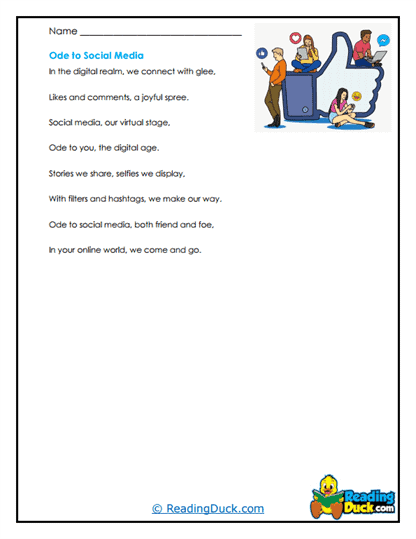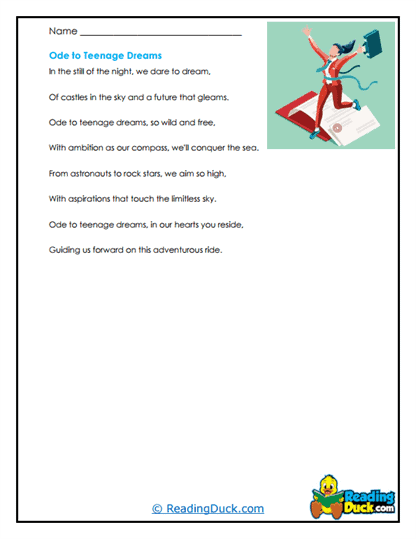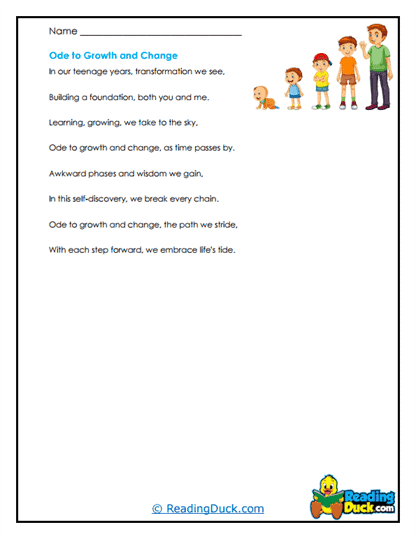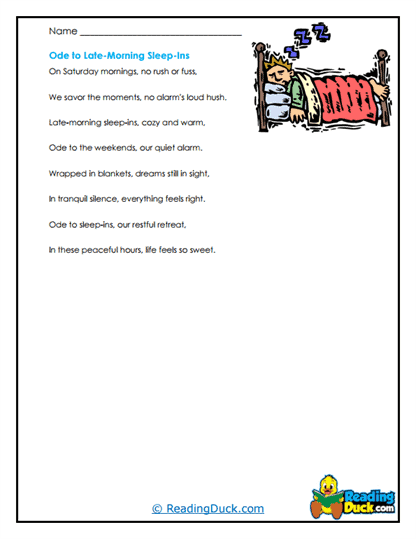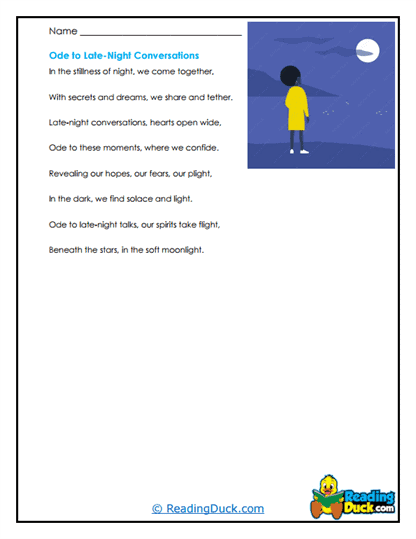Ode Worksheets
About Our Ode Worksheets
Our Ode Worksheets offer a rich and insightful exploration of one of the most celebratory and reflective forms of poetry. Part of the Reading Poetry category within the Genres section, this collection invites students to delve into the sophisticated structure and deep emotional resonance of odes. These worksheets feature carefully selected reading passages that align with the ode genre, accompanied by multiple-choice questions, short answer questions, and open-ended response prompts to encourage students to engage with the text on multiple levels.
These resources are available in a convenient PDF format, allowing for easy downloading, printing, and distribution in various learning environments. Each worksheet includes a downloadable answer key, which simplifies grading and assessment for educators. Through these Ode Worksheets, students will not only enhance their comprehension and analytical skills but also discover the joy of expressing admiration, awe, or reflection through poetic form.
Understanding the Ode: Themes, Structure, and Significance in Poetry
The ode is a type of lyrical poetry that originated in Ancient Greece and was later popularized by poets like Horace, Keats, and Shelley. Traditionally, odes are formal poems that praise a person, place, object, or idea. They are often meditative, reflecting on the subject with deep admiration, reverence, or celebration. Odes offer a way to elevate the everyday into the extraordinary, using rich language and thoughtful structure to explore complex emotions or abstract concepts.
One of the defining characteristics of an ode is its structure. While traditional odes often adhere to strict formal patterns, such as stanzas of uniform length and consistent rhyme schemes, modern odes may experiment with form while retaining the genre’s characteristic focus on praise and reflection. Odes can be divided into three main types: Pindaric (with a triadic structure), Horatian (with uniform stanzas), and irregular odes (which are more flexible in their form). The genre’s focus on elevated language and philosophical or emotional depth makes it essential to poetry because it teaches students how language can be used to express admiration, wonder, or reflection in ways that are both structured and artistic.
Studying odes is crucial because it allows students to explore how poets convey respect, celebration, or contemplation of a subject through careful use of form, meter, and poetic devices. Odes often explore themes like beauty, nature, love, and the transience of life, which are timeless and universal in their appeal.
- Key Themes: Praise, admiration, reflection, beauty, the passage of time.
- Characteristics: Formal structure, use of elevated language, consistent stanzas or flexible experimentation with form.
- Importance: Odes encourage students to think deeply about language and how it can be used to honor or reflect upon meaningful subjects.
These worksheets, presented in easy-to-use PDF format, offer students the chance to analyze and appreciate the ode as a literary form, while also providing teachers with simple answer keys for efficient grading and feedback.
Enhancing Literary Skills Through Ode Study
Our Ode Worksheets are designed to strengthen students’ core literary skills, including reading comprehension, critical thinking, and creative expression. By studying the intricate structure and evocative language of odes, students can better understand how poets use form and word choice to convey powerful emotions and thoughts.
Each worksheet set begins with multiple-choice questions that focus on key elements of the ode, such as its rhyme scheme, tone, and thematic content. These questions build a strong foundation in understanding the poem’s structure and message, helping students grasp the primary features of the ode before moving into deeper analysis.
Short answer questions push students to explore specific aspects of the ode’s construction, such as the use of metaphor, imagery, and alliteration, and how these elements contribute to the poem’s overall impact. Open-ended response questions invite students to reflect on the emotional and philosophical depth of the ode, encouraging them to consider how the poet’s subject matter is enhanced by the chosen form and language.
Through these exercises, students will develop a range of essential skills:
- Reading Comprehension: Students learn to identify and interpret the key elements of the poem, such as its tone, structure, and themes.
- Critical Thinking: By analyzing the poet’s use of literary devices and form, students deepen their understanding of how poetry conveys complex ideas and emotions.
- Creative Expression: Open-ended responses allow students to engage personally with the text and explore their interpretations of the ode’s meaning.
These worksheets offer a valuable opportunity for students to strengthen their analytical abilities while also appreciating the beauty and depth of this reflective poetic form.
Adaptable Resources for All Learning Environments
One of the standout features of our Ode Worksheets is their adaptability to various educational settings, including traditional classrooms, homeschooling environments, and independent study. The flexibility of the ode’s structure, combined with the range of themes it explores, makes it a perfect genre to study in diverse learning environments.
In classroom settings, these worksheets can be used for group analysis, individual work, or creative writing exercises. Teachers might assign different odes to different groups, encouraging students to analyze how various poets use the form to celebrate or reflect on different subjects, and then present their findings to the class. The worksheets also support individual assignments, allowing students to work through the questions at their own pace and explore their personal reactions to the ode’s themes.
For homeschooling, the Ode Worksheets provide a structured yet flexible resource. Parents or educators can use these worksheets to introduce students to the ode in a guided manner, with opportunities to adjust the difficulty of the questions according to the student’s skill level. Homeschool students can use these worksheets to explore odes at their own pace, developing both analytical and creative skills in a supportive environment.
Independent learners will benefit from the self-guided nature of the worksheets. The PDF format ensures easy access, while the answer key provides immediate feedback, allowing students to track their progress. These worksheets are ideal for independent study projects, enrichment activities, or supplemental learning outside the classroom.
- Classroom Use: Group discussions, individual assignments, and creative writing projects.
- Homeschooling: Tailored to different skill levels, offering a blend of structure and flexibility.
- Independent Study: Self-paced learning with the option for immediate feedback through the answer key.
The versatility of these worksheets ensures that they can be effectively used in any learning environment, making them a valuable resource for educators and students alike.
Encouraging Close Reading and Critical Analysis
Studying odes allows students to sharpen their skills in close reading and critical analysis. Our Ode Worksheets are specifically designed to guide students through the process of examining the intricate details of the poem, from its structure to its use of literary devices, helping them appreciate the artistry behind each ode.
Through carefully crafted questions, students are encouraged to think deeply about how the poet’s choice of form, meter, and language contributes to the overall impact of the poem. For example, they might be asked to analyze how the consistent rhyme scheme of a traditional ode creates a sense of harmony and reverence or to explore how the use of imagery and metaphor elevates an everyday object to something worthy of admiration.
These worksheets also emphasize the importance of literary devices like metaphor, symbolism, and alliteration in creating the ode’s tone and mood. Students learn how these devices work together to create a deeper layer of meaning, whether the poet is reflecting on nature, life, or a beloved figure. The guided close reading exercises teach students to pay attention to subtle details and nuances in the text, fostering a more refined understanding of poetry.
- Close Reading: Encourages students to examine how form, meter, and literary devices work together to create meaning.
- Literary Devices: Focus on metaphor, imagery, alliteration, and symbolism in building the ode’s emotional and philosophical depth.
- Deeper Interpretation: Prompts students to think critically about the ode’s subject matter and how language enhances its message.
By engaging with these exercises, students gain the confidence and skills needed to interpret and analyze more complex literary works.
Inspiring Creative Expression Through Writing Odes
One of the most rewarding aspects of studying odes is the opportunity for students to create their own poems within this form. Our Ode Worksheets include creative writing prompts designed to inspire students to write their own odes, mirroring the themes, structure, and techniques they’ve studied in the readings.
Each worksheet set features guided writing exercises that encourage students to choose a subject of admiration—whether it’s a personal object, a place, a loved one, or a concept—and compose an ode that reflects their own feelings of reverence or celebration. These prompts help students practice applying the formal structure of an ode while also allowing them to experiment with language, imagery, and poetic devices.
Writing odes provides students with an opportunity to explore their creative voice within a structured framework. As they craft their poems, students gain a deeper understanding of how form and content work together to create meaning in poetry, while also developing their skills as writers.
- Writing Prompts: Guided exercises that help students compose their own odes, drawing inspiration from personal experiences or admired objects.
- Creative Expression: Encourages students to explore their feelings of admiration or reflection through the formal structure of an ode.
- Applying Techniques: Writing odes reinforces the use of literary devices and form, helping students gain mastery of the genre.
These writing exercises allow students to practice the techniques they’ve learned, while also fostering their creative expression and confidence as poets.
Conclusion: A Comprehensive Tool for Exploring the Ode Genre
Our Ode Worksheets provide a comprehensive and engaging resource for both educators and students, offering a well-rounded approach to studying one of poetry’s most reflective and celebratory forms. By combining reading comprehension, critical analysis, and creative writing, these worksheets encourage students to appreciate the depth and beauty of odes while building essential literary skills.
Whether used in the classroom, for homeschooling, or as part of an independent study program, these worksheets provide a flexible and adaptable way to explore the genre. Through close reading exercises, thoughtful analysis, and creative writing prompts, students gain a deeper understanding of how poets use language to elevate the ordinary into something extraordinary. With our Ode Worksheets, students not only learn to analyze odes but also have the opportunity to craft their own, discovering the joy of expressing admiration and reflection through poetry.


